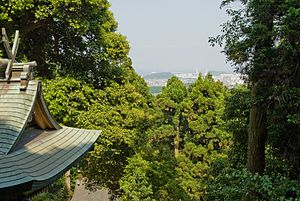Jōgen (Kamakura period) facts for kids
This page is about the Japanese era name Jōgen occurring during the Kamakura period. For other uses, see Jōgen.
Jōgen (承元), also known as Shōgen, was a Japanese era name (年号, nengō, lit. year name) after Ken'ei and before Kenryaku. This period spanned the years from October 1207 through March 1211. The reigning emperors were Tsuchimikado-tennō (土御門天皇) and Juntoku-tennō (順徳天皇).
Events of the Jōgen era
- 1208 (Jōgen 2, 6th month): Tsuchimikado went to the Kumano Sanzan Shrine.
- 1210 (Jōgen 4, 5th month): The emperor returned to the Kumano Shrine.
- 1210 (Jōgen 4, 6th month): Tsuchimikado accepted Hideyasu of Kazusa as part of the court.
- 1210 (Jōgen 4, 8th month): The emperor visited the Kasuga Shrine.
- 1210 (Jōgen 4, 9th month): A comet with a very long tail appeared in the night sky.
- 1210 (Jōgen 4, 25th day of the 11th month): In the 12th year of Tsuchimikado's reign, the emperor abdicated for no particular reason; and the succession (senso) was received by his younger brother, the second son of the former-Emperor Go-Toba. Soon after, Emperor Juntoku's role as emperor was confirmed (sokui).
Related pages
- National Diet Library, "The Japanese Calendar" -- historical overview plus illustrative images from library's collection
| Jōgen | 1st | 2nd | 3rd | 4th | 5th |
|---|---|---|---|---|---|
| 1207 | 1208 | 1209 | 1210 | 1211 |
| Preceded by: Ken'ei |
Era or nengō: Jōgen |
Succeeded by: Kenryaku |

All content from Kiddle encyclopedia articles (including the article images and facts) can be freely used under Attribution-ShareAlike license, unless stated otherwise. Cite this article:
Jōgen (Kamakura period) Facts for Kids. Kiddle Encyclopedia.

